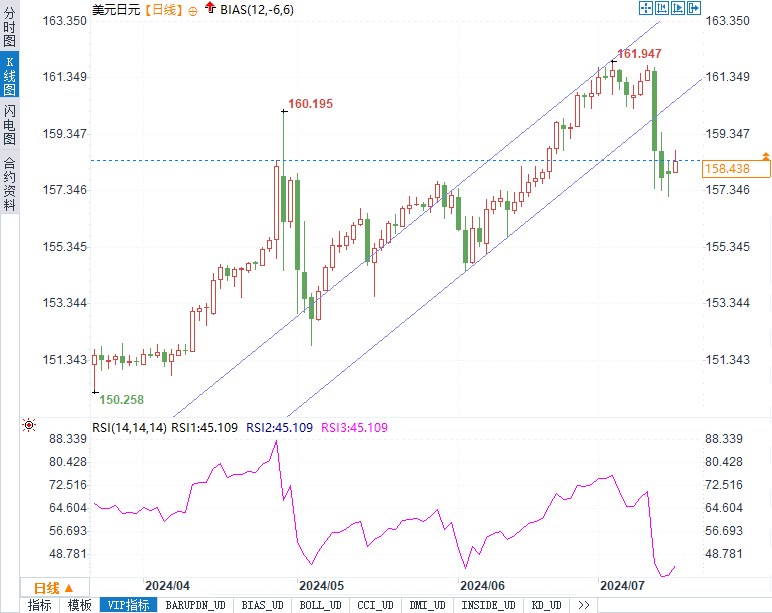Can the intervention of 3.5 trillion yen turn the tide? Where is the next key resistance level for USD/JPY?
On the chessboard of the financial market, the Japanese yen seems to be experiencing a subtle balancing game. On Tuesday (July 16th), the US dollar/Japanese yen continued its upward trend and rebounded to a high of 158.442. Despite the dovish signals from Federal Reserve Chairman Powell and estimates that Japanese authorities may have invested 3.37 trillion to 3.57 trillion yen to prevent the rapid depreciation of the yen, the performance of the yen remains moderate. Market participants are now focusing on the upcoming release of US retail sales data in order to capture new trading signals from it.
Japan may invest $13.5 billion to intervene in the yen last Friday
According to a comparison between the Bank of Japan's current account data and estimates from currency brokers, Japan may intervene in the currency market last Friday to support the yen. Comparison shows that the scale of intervention may be around 214 trillion yen (13.5 billion US dollars). The Bank of Japan predicted last Wednesday that its current account may decrease by 2.74 trillion yen due to government fiscal factors. Private currency brokerage firms including Central Tanshi and Ueda Yagi Tanshi expect an average decline of 600 billion yen in their current account funds.
The logic behind the strengthening of the US dollar
The strengthening of the US dollar is partly due to the increased risk aversion triggered by the assassination of former US President Trump last Saturday. However, the cooling of US inflation has also increased market expectations for the Fed's September interest rate cut, which may limit the upward potential of the US dollar. Investors are turning their attention to the US June retail sales data, which will be released later today, hoping to gain more investment leads from it.
According to the Chicago Mercantile Exchange Group's (CME) Fed Watch tool, the market currently predicts a high probability of 85.7% for the Federal Reserve to cut interest rates by 25 basis points at its September meeting, a significant increase from 71.0% a week ago.
The Subtle Position of the Federal Reserve
Powell mentioned in his speech on Monday that this year's three inflation data show that inflation is expected to continue to reach the Federal Reserve's target, indicating that the pace of interest rate cuts may not be far away. San Francisco Federal Reserve President Mary Daley also expressed a similar view, believing that inflation is cooling down and increasing people's confidence that the inflation rate will reach 2%. However, she also emphasized that more information is needed before making a decision on interest rates.
Potential impact of political factors
In his national speech at the White House, US President Biden condemned all political violence and called for national unity. He pointed out that not only were there attacks on Trump over the weekend, but there could be violent incidents in multiple aspects during the election year. This political uncertainty may also add a layer of complexity to the financial market.
Technical Analysis of the Japanese Yen
From a technical analysis perspective, the daily chart of USD/JPY shows a strengthening bullish bias. Analyst Akhtar Faruqui pointed out that as the currency pair rises to the lower limit of the upward channel pattern, the 14 day Relative Strength Index (RSI) is also slightly below the 50 level, indicating that further gains may strengthen the bullish trend.
Currently, the resistance level facing the US dollar/Japanese yen is around 159.46 on the nine day moving average (EMA), followed by the lower boundary of the uptrend at 160.30. If we can return to trading within the upward channel, it may improve market sentiment towards the US dollar/Japanese yen, with a potential target near the upper boundary of the upward channel at 163.70.

The viewpoint of institutional analysts
Francesco Pesole, a foreign exchange analyst at ING, observed that the Japanese Ministry of Finance has adjusted its foreign exchange intervention strategy. The increase in trading volume of Japanese yen futures seems to be consistent with signs of foreign exchange intervention, following the weakness of the US Consumer Price Index (CPI) data.
UBS's foreign exchange strategist also pointed out that speculative investors are holding short positions in the Japanese yen at levels close to historical highs. They believe that if US economic data continues to show a soft landing, the USD/JPY may experience a period of correction.
BBH's foreign exchange strategists, on the other hand, emphasize that although the recent weak US data poses a challenge to their views, they believe that the background of sustained inflation and strong growth in the US remains largely unchanged. They specifically pointed out that Federal Reserve officials are increasingly concerned about the weakness of the labor market.
The dynamics of the Japanese yen market are always full of uncertainty, but professional market traders can always find opportunities amidst fluctuations. Traders need to maintain keen insight into the delicate balance between Federal Reserve policy expectations and the yen, while closely monitoring upcoming economic data and policy developments.
Tips:This page came from Internet, which is not standing for FXCUE opinions of this website.
Statement:Contact us if the content violates the law or your rights
